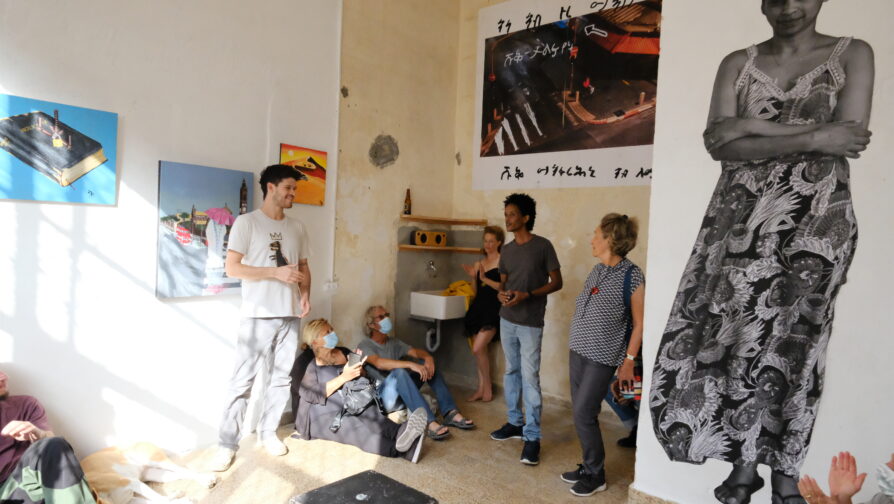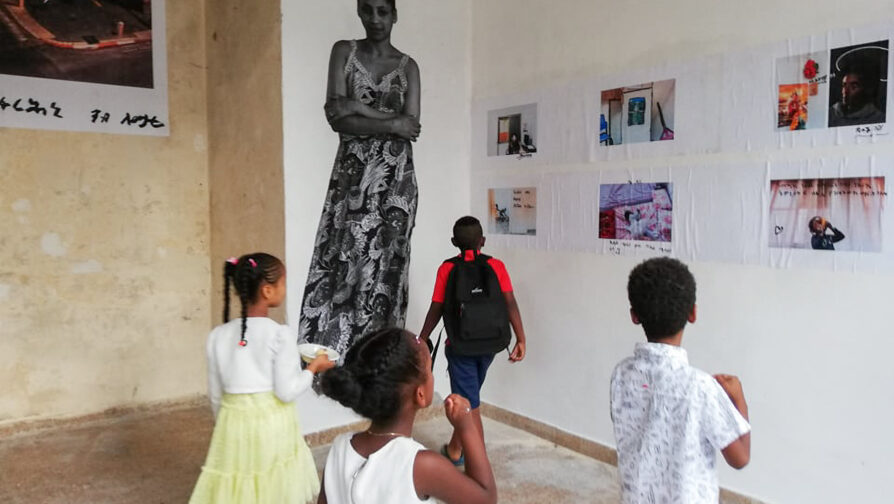
Yohana stands with two of her three children in the alley next to her house, dressed for the Easter holiday, on May 2, 2021.
Haifa’s Hadar neighborhood is known for being one of the most diverse neighborhoods in Israel, with dozens of different cultures ping-ponging across the narrow alleyways and crumbling buildings. Jews, Muslims, Christians, and Baha’i live in the neighborhood, which feature some of the oldest businesses in the city.
Around 700 asylum seekers, mostly families from Eritrea, also call the Hadar neighborhood their home, out of approximately 41,000 asylum seekers in Israel and 8,500 children. In an attempt to increase the community’s visibility, photographer Daniel Rolider, 26, captured a few moments from their lives for an exhibit as part of the Incubator for Site-Specific Art, an initiative of the six major Haifa Museums, including the Haifa Museum of Art.
“Lots of people don’t know about the (Eritrean) community in Haifa, so they live more quietly,” said Rolider, who spent six months photographing the community for the exhibit “In Hadar, Going Nowhere.” “Someone sees a person with black skin in south Tel Aviv, and they may immediately have a lot of ideas or negative connotations about them, but in Haifa that doesn’t happen as much.”
“The kids are in schools with Israelis so the education is better, and in general there’s just a much better mixing between the Israeli and Eritrean communities in Haifa than in Tel Aviv,” said Rolider. “But there’s the disadvantage that they’re not as large of a community, so they don’t feel as much at home as south Tel Aviv.”
UNHCR works with the community in Haifa through ALEF, a grassroots group started by asylum seekers to organize and empower themselves. In 2019, ALEF became part of the ARDC Israel Family (African Refugee Development Center), which is one of UNHCR’s partners.
“ALEF does really wonderful projects for women’s therapy groups in Tigrinya, and they were the first ones to give out tablets for children during corona,” said Ron Peleg, a member of Community Services Unit at UNHCR office in Israel. “We are working directly with ALEF on individual cases and larger community issues, including special needs of this community.”
Eritrean artist Afwerke Teame, who studied Fine Art at the Minshar School of Art in Tel Aviv, helped Rolider make connections with the Haifa community and is featured in two of the photos himself. Teame is one of two UNHCR Refugee Outreach Volunteers in Haifa, helping UNHCR identify people in need of additional support and acting as a bridge between UNHCR and the community. There are a total of seven Refugee Outreach Volunteers across Israel in different cities.

. Daniel Rolider, left, and Afwerke Teame, center, discuss the project on the opening of the exhibit on October 29, 2021. (courtesy)
Rolider wanted to use his platform at the Haifa Museum of Art to raise awareness of the community among the larger Israeli public, but the place where his exhibit had the most impact was in the very neighborhood where he shot the photos.
As part of the residency, the artists were encouraged to complete an “art intervention” connected to their project. Rolider printed his photos on poster-sized paper and hung them up at the Meso gallery, which is on a well-trafficked street in Hadar’s Talpiyot shuk, near where many Eritreans live. He also printed four photos on large pieces of fabric, more than three meters high, and hung them in the middle of Sirkin St, just off the main drag of the market.
“When I put of the photos in the shuk, people were stopping by and telling their neighbors ‘I saw your photo!’” Rolider said. “Kids were entering and seeing their friends’ faces. That was the most meaningful presentation of the project for me, to give them a place of representation. Most people haven’t seen themselves printed and put on a building on a three-meter-high poster. They took photos of their photos. So maybe my photos aren’t going to lead to a change on a political level, but they can on a personal level.”
Rolider also asked the subjects of his photos to draw or write on the photos anything they thought the viewer might be missing. Rolider was inspired by photographers Bieke Depoorter and Jim Goldberg, who have also played around with subjects adding their own texts to printed photos, what Rolider calls “pushing the envelope of what constitutes photojournalism.”
Some people drew over their faces to stay anonymous, others wrote messages of love and longing, others celebrated favourite football teams.

Children from the Eritrean community look at photos on Sirkin St in the Hadar neighborhood on October 29, 2021. (courtesy)
“It was weird because it’s a weird request in itself,” Rolider said. “But I think they liked it and afterwards when people saw the project, Eritreans that weren’t connected to it, when they recognized their own language on the photos it made a connection with them that was really special.”
The photos are on display at the Museum of Art in Haifa. The photo series also took second place in the “Long Exposure” category of the Local Testimony photography exhibition in Tel Aviv in 2021.
Rolider said after six months of weekly visits to the community, he plans to continue documenting their journey and their hopes of finding a durable solution, in order to shed more light on the issue and increase public awareness. “I think the parts I most remember from the project, is that it was about how the community saw themselves.”
Share on Facebook Share on Twitter